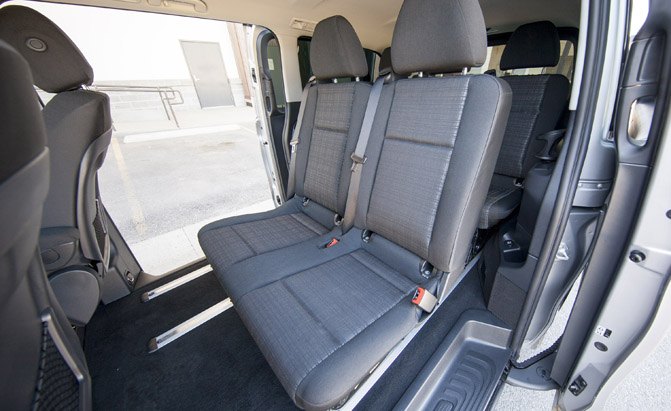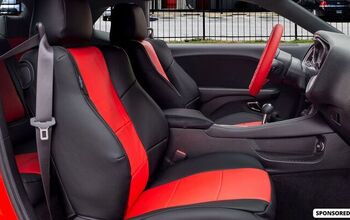2016 Mercedes-Benz Metris Review
Meet the new Metris, which Mercedes-Benz assures us is not a minivan.
They’d like you to classify it as a small van, or perhaps even a mid-size van, seeing as how it is slightly larger in dimensions and capacity than small vans like the Nissan NV200, Ford Transit Connect and Ram Promaster City. In fact, the Metris is nearly the same size as the soon-to-be-discontinued Ram C/V Tradesman, which is the cargo version of the Dodge Grand Caravan, Chrysler’s ubiquitous miniva… oh, darn, there’s that word again. Sorry, Mercedes. So what separates the Metris from a mi— er, from one of those vehicles?
The Metris, like the bigger Sprinter, is designed to be a commercial vehicle. Like the Sprinter, the Metris will be sold in cargo and passenger versions, but while Sprinter sales are roughly 85% cargo and 15% passenger, Mercedes expects an even split for the Metris. The cargo version of the Metris is basically a box on wheels, while passenger versions will be available with seven or eight seats arranged in a 2-2-3 or 2-3-3 layout.
FAST FACTS
| Engine: | 2.0 L turbocharged four-cylinder engine, 208 hp |
| Trans: | 7-speed automatic |
| Base price: | Cargo begins at $29,945 after destination charges, Passenger starts at $32,495 |
It’s Not a Minivan
“Hmm,” you might be thinking, “that sounds an awful lot like a—” Shhhh! Don’t say it!
Forget about those fancy disappearing third-row seats you’ll find in other manufacturer’s you-know-whats. The Metris’ rear seats are sturdily bolted to the floor, and with no fancy flip-and-fold mechanisms to get in the way, they are proper seats: Big, supportive, and a comfortable distance off the floor.
It’s a Serious Van
Cargo vans, meanwhile, offer 186 cubic feet of cargo space and a 2,500 lb. payload capacity. Both versions can tow 4,650 lbs., and with a gross combined weight rating (GCWR) of 11,684 lbs, they can tow even with a full tank of fuel and over a ton of passengers or cargo on board.
Surprisingly Nice Interior
In light of the Metris’ commercial role, the interior is not as luxurious as Mercedes’ passenger cars, but nor is it as Spartan as the Sprinter. The dash lacks the wood or brushed-aluminum trim you’d find in an E-class, but the materials of which it is made are significantly nicer than the Sprinter’s featureless plastic.
Infotainment is provided by a commercial-grade stereo with an optional navigation system (which, come to think of it, is a nice alternative to the complicated dial-operated system Mercedes uses in its cars and SUVs).
The delivery driver who has to pilot the Metris may not feel like she won the lottery, but clearly Mercedes recognizes that this is her office and she will be spending day after day here. It’s comfortable, pleasant and ergonomically sound, as any workspace ought to be.
Single Drivetrain
We were allowed a brief drive in the pre-production Metris, and we liked what we experienced. The Metris is based on a European-market van called the Vito (a name Mercedes avoided for the North American market due to its Godfather-like overtones; bear in mind that up until recently, MBUSA was based in New Jersey).
While Euro-market Vitos get diesel power—the same 2.1-liter turbodiesel as used in the Sprinter and the E-Class, as a matter of fact—the Metris runs on gasoline. Its 208 horsepower 2.0-liter turbocharged four-cylinder engine is the same as the one found in the CLA and GLA, but the seven-speed automatic is a conventional torque-converter unit rather than a twin-clutch.
Back in the Old Country, the Metris is available in front-, rear-, or all-wheel-drive configurations; it arrives Stateside with rear-wheel-drive, a key differentiator from other mi—, er, from other seven-or-eight-seat mid-size one-box-design vehicles known by a popular moniker we are trying our best not to use.
Turbo Power
Mercedes claims the tightest turning radius in its class, though its 38.7′ turning circle is actually wider than the Nissan NV200 and short-wheelbase Ford Transit Connect. (This leads us to wonder how they define the class—surely they aren’t talking about, you know, those vehicles?)
We’d like to say the Metris drives like a minivan, but since the Metris is not a minivan, we won’t.
Safety and Pricing
One thing that sets the Metris apart from other commercial vans is the availability of safety equipment. Besides a host of airbags (including three-row side curtain airbags for passenger versions), the Metris offers the load-adaptive electronic stability control system found in the Sprinter, which can calculate the loaded van’s weight and center of gravity and adjust its operating parameters accordingly. Options include a lane-departure warning and correction system, a blind-spot warning system, and a rear-view camera, along with a self-parking system that can steer the Metris out of tight spots as well as helping it to squeeze into them.
That said, Mercedes claims that one of the advantages to a Metris is low TCO (Total Cost of Ownership), and there’s more to TCO than price. Mercedes touts its commercial-grade dealerships, which offer service bays, technicians and advisors dedicated to commercial van customers—something Metris customers should be able to avoid thanks to the Metris’ 15,000 mile service intervals. And Mercedes does have a rather good reputation for building rugged and reliable vehicles. That’s important, since a commercial vehicle can’t make money for its owners when it’s sitting in the shop.
The Verdict: 2016 Mercedes-Benz Metris Review
All in all, we think the new Metris has a bright future The cargo van offers a great deal of flexibility and capacity, and the passenger version is clearly designed for commercial passenger hauling without the usual family-oriented frivolities. This is a commercial van in miniature—sort of a mini-van. Except it isn’t.
LOVE IT
- Not a modified minivan
- mid-size
- Flexible engine
- Car-like road manners
LEAVE IT
- Non-premium interior
- Expensive
More by Aaron Gold



































































































Comments
Join the conversation
....Cool Text Income by autoguide
Very entertaining to read article Aaron! Sounds like a terrible vehicle with no place, but I always think that about commercial grade products when I compare them to consumer products. That's SUPER weird that it can be has=d in FWD, RWD or AWD... it's like a Forza drivetrain swap.